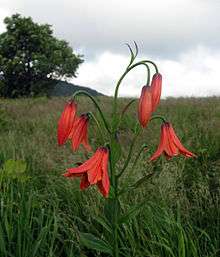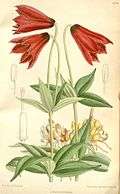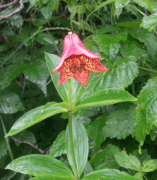Lilium grayi
Lilium grayi (Gray's lily, Orange bell lily, Roan lily)[3][4] is a perennial plant that is endemic to the eastern US states of North Carolina, Virginia, and Tennessee, growing in moist, acid soil in the Appalachian mountains on higher elevation meadows, bogs, and seeps.[5] The plant was introduced to Royal Botanic Gardens, Kew in 1890 and was featured in the Kew Bulletin in 1892.[6]
| Lilium grayi | |
|---|---|
 | |
| Scientific classification | |
| Kingdom: | Plantae |
| Clade: | Tracheophytes |
| Clade: | Angiosperms |
| Clade: | Monocots |
| Order: | Liliales |
| Family: | Liliaceae |
| Genus: | Lilium |
| Species: | L. grayi |
| Binomial name | |
| Lilium grayi | |
| Synonyms[2] | |
| |
Taxonomy
The species was named to honor Asa Gray, an eminent American botanist of the mid-19th century who discovered Lilium grayi in 1840 in the Appalachian mountains on Roan Mountain. At the time, Gray wasn't sure that it was a unique species, thinking that it might be a variety of Lilium canadense. He found more plants there in 1879 on a trip with Charles Sprague Sargent. Sereno Watson, curator at the Gray Herbarium of Harvard University, found several differences from Lilium canadense, confirming that it was a distinct species, and named the plant in honor of his colleague.[7][6][8][5]
Description
Lilium grayi reaches 2 to 5 ft (0.61 to 1.52 m) tall. The 2 to 3 in (5.1 to 7.6 cm) leaves are lanceolate to oblong-lanceolate and carried around the stem in whorls. The 2.5 in (6.4 cm) reddish-orange bell-shaped flowers bloom in early summer and are carried on several umbels in a tiered style. Sepals and petals have purple spots.[9][4]
Lilium grayi is closely allied to Lilium canadense, the Canada lily, and was originally thought to be that plant. L. grayi tends to have smaller flowers that are less pendulous, more open at bottom, and more suddenly narrowed at the apex.[10]
Habitat
Lilium grayi is native to mountainous regions in only three U.S. states: North Carolina, Virginia, and Tennessee.[11] It grows in sandstone and acidic soils, meadows, open areas near summits, forest meadows, and bluff outcrops. It grows in full sunlight. Habitat is threatened by overgrazing by cattle, European wild boars, and rabbits. Increase of tree canopy also decreases available open habitat. The plant has also been reduced by illegal collecting and is susceptible to fungal infections.[5]
Gallery
 1892 illustration[12]
1892 illustration[12] Photo of single flower Taken on Roan Mtn.
Photo of single flower Taken on Roan Mtn.
References
- "Lilium grayi". NatureServe. Retrieved 2015-10-13.
- Kew World Checklist of Selected Plant Families
- Leonard Adkins (10 August 2006). Wildflowers of the Appalachian Trail, 2nd. Menasha Ridge Press. p. 110. ISBN 978-0-89732-974-3. Retrieved 2 September 2012.
- "Lilium grayi". Wildflowers. North Carolina State University. Retrieved 2 September 2012.
- "Lilium Grayi". National Collection of Imperiled Plants. Missouri Botanical Garden. Archived from the original on 26 October 2011. Retrieved 2 September 2012.
- Christian Lamb (1 October 2004). From the Ends of the Earth: Passionate Plant Collectors Remembered in a Cornish Garden. Christian Lamb. p. 165. ISBN 978-1-903071-08-3. Retrieved 2 September 2012.
- Alice Lounsberry (1901). Southern Wild Flowers and Trees: Together with Shrubs, Vines and Various Forms of Growth Found Through the Mountains, the Middle District and the Low Country of the South. F.A. Stokes Company. p. 51. Retrieved 2 September 2012.
- IPNI Listing for Lilium Grayi
- Christopher Brickell, The RHS Encyclopedia of Garden Plants, Dorling Kindersley, London, 1996, p615. ISBN 0-7513-0436-0
- Joseph Dalton Hooker (1892). Curtis's botanical magazine. Reeve Brothers. p. 7234. Retrieved 2 September 2012.
- Biota of North America Program 2014 county distribution map
- illustration from Curtis botanical magazine v.118, plate 7234, 1892 Author Sir Joseph Dalton Hooker (1817 - 1911)
